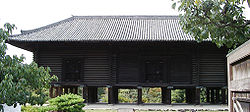Bunka
Appearance
| Part of a series on the |
| History of Japan |
|---|
 |
Bunka (文化) was a Japanese era name (年号,, nengō,, lit. "year name") after Kyōwa and before Bunsei. The period spanned the years from January 1804 to April 1818.[1] The reigning emperors were Kōkaku-tennō (光格天皇) and Ninkō-Tennō (仁孝天皇).
Change of era
- February 11, 1804 (Bunka gannen (文化元年)): The new era name of Bunka ( meaning "Culture" or "Civilization") was created to mark the start of a new 60-year cycle of the Heavenly Stem and Earthly Branch system of the Chinese Calendar which was on New Year's Day, the new moon day of 2 November 1804. The previous era ended and a new one commenced in Kyōwa 4.
Events of the Bunka era
- 1804 (Bunka 1): Daigaku-no kami Hayashi Jussai (1768–1841) explained the shogunate foreign policy to Emperor Kōkaku in Kyoto.[2]
- June 1805 (Bunka 2): Genpaku Sugita (1733–1817) is granted an audience with Shogun Ienari to explain differences between traditional medical knowledge and Western medical knowledge.[3]
- September 25, 1810 (Bunka 7, 27th day of the 8thmonth): Earthquake in northern Honshū (Latitude: 39.900/Longitude: 139.900), 6.6 magnitude on the Richter Scale.[4]...Click link for NOAA/Japan: Significant Earthquake Database
- December 7, 1812 (Bunka 9, 4th day of the 11th month): Earthquake in Honshū (Latitude: 35.400/Longitude: 139.600), 6.6 magnitude on the Richter Scale.[4]
- 1817 (Bunka 14): Emperor Kokaku travelled in procession to Sento Imperial Palace, a palace of an abdicated emperor. The Sento Palace at that time was called Sakura Machi Palace. It had been built by the Tokugawa Shogunate for former-Emperor Go-Mizunoo.[5]
Notes
- ^ Nussbaum, Louis-Frédéric. (2005). "Bunka" Japan Encyclopedia, p. 91, p. 91, at Google Books; n.b., Louis-Frédéric is pseudonym of Louis-Frédéric Nussbaum, see Deutsche Nationalbibliothek Authority File.
- ^ Cullen, L.M. (2003). A History of Japan, 1582-1941: Internal and External Worlds, pp. 117, 163.
- ^ Sugita Genpaku. (1969). Dawn of Western Science in Japan: Rangaku Kotohajime, p. xvi.
- ^ a b Online "Significant Earthquake Database" -- U.S. National Oceanic and Atmospheric Administration (NOAA), National Geophysical Data Center (NGDC)
- ^ National Ditigial Archives of Japan, ...see caption describing image of scroll
References
- Cullen, Louis M. (2003). A History of Japan, 1582-1941: Internal and External Worlds. Cambridge: Cambridge University Press. 10-ISBN 052182155X/13-ISBN 9780521821551; 10-ISBN 0521529182/13-ISBN 9780521529181; OCLC 50694793
- Nussbaum, Louis Frédéric and Käthe Roth. (2005). Japan Encyclopedia. Cambridge: Harvard University Press. 10-ISBN 0-674-01753-6; 13-ISBN 978-0-674-01753-5; OCLC 48943301
- Sugita Genpaku. (1930). Dawn of Western Science in Japan (蘭學事始, Rangaku kotohajime). Tokyo: Iwanami Shoten. OCLC 9424185
External links
- National Diet Library, "The Japanese Calendar" -- historical overview plus illustrative images from library's collection
- National Archives of Japan: Sakuramachiden Gyokozu, scroll depicting Emperor Kōkaku in formal procession, 1817 (Bunka 14).
